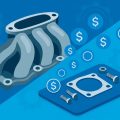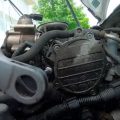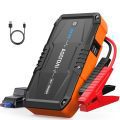In this guide, “How to Use an OBD-II Scanner for Engine Diagnostics,” we will walk you through the essential steps to effectively utilize an OBD-II scanner to diagnose engine issues and monitor emissions systems. Understanding how to operate this tool is vital for vehicle maintenance, enabling you to pinpoint problems accurately and efficiently. Whether you’re a seasoned mechanic or a car enthusiast, this step-by-step approach will empower you to maintain your vehicle’s performance and address concerns before they escalate.



Gather Necessary Tools
Gather necessary tools before commencing any diagnostic work on your vehicle. Ensure you have the following items ready:
- Obtain an OBD-II scanner. This device is essential for reading diagnostic trouble codes (DTCs) and communicating with your vehicle’s onboard computer.
- Confirm that your vehicle is equipped with a compliant OBD-II port, typically located under the dashboard near the driver’s seat.
- Keep the vehicle’s ignition key handy, as you will need it to power on the vehicle and the scanner during the diagnostic process.
Familiarize yourself with the user manual of the OBD-II scanner. Read through the instructions to understand how to connect the scanner to the OBD-II port, navigate the interface, and interpret the diagnostic codes it retrieves. This preparation ensures a smooth diagnostic experience and helps you efficiently address any issues that may arise.


Locate the OBD-II Port
Locate the OBD-II port by first entering your vehicle and positioning yourself in the driver’s seat. Check beneath the dashboard directly beneath the steering column; this is a common placement for the OBD-II port. If you cannot see it right away, feel around the area to identify any covers that may need to be removed. Look for a rectangular connector, usually around 2 inches wide, which may be secured by a plastic cover.
Inspect the driver’s side area thoroughly, as the port may also be located slightly to the left or right of the steering column. Use a flashlight if necessary to illuminate dark spaces, ensuring you can see clearly. Once you find the port, take note of its orientation and shape, as this will help when connecting your diagnostic tool later.
Connect the OBD-II Scanner
Plug the OBD-II scanner into the OBD-II port, typically located under the dashboard near the steering wheel. Ensure it is securely connected to avoid any communication errors. The OBD-II port usually resembles a trapezoidal shape and may have a cover that needs to be removed.
Power on the scanner by checking if it turns on automatically; this is common with most models. If it does not power on, turn the vehicle’s ignition to the ‘ON’ position without starting the engine. This action activates the vehicle’s electronic systems, allowing the scanner to communicate effectively.
- Check that the dashboard lights up when the ignition is in the ‘ON’ position.
- Look for the scanner’s display to illuminate, confirming it is functioning.
For example, if your vehicle has a key ignition, insert the key and turn it to the second position. If using a push-button start, press the button without pressing the brake pedal.
Read the Diagnostic Codes
- Connect the scanner to the vehicle’s diagnostic port, usually located under the dashboard near the driver’s seat.
- Turn on the vehicle’s ignition without starting the engine.
- Follow the scanner’s prompts, which may include selecting the vehicle make, model, and year.
- Navigate through the menus using the arrow keys or touch screen options until you reach the section for diagnostic trouble codes (DTCs).
- Select the option to read or retrieve codes.
- Record any codes displayed on the scanner’s screen. Each code corresponds to a specific issue or malfunction within the engine system, providing crucial information for troubleshooting.
- If available, review any additional details or descriptions associated with each code for better understanding.
- Note any pending codes, as these can indicate intermittent issues that may not trigger a check engine light immediately.
Interpret the Codes
Refer to the scanner’s code library or your vehicle’s service manual immediately after retrieving the diagnostic codes. Locate the specific code associated with the issue, which will provide insight into the nature of the engine problem. Cross-reference the code with the descriptions and troubleshooting steps listed in the manual or library to gain a clearer understanding of what the code signifies.
Analyze the information provided for each code, paying attention to any associated symptoms or conditions outlined. Determine the recommended diagnostic or repair procedures, and prioritize actions based on severity and impact on vehicle performance. Use this knowledge to guide your next steps, whether it involves further diagnosis, repairs, or consulting a professional mechanic.
Clear the Codes (If Necessary)
Clear the diagnostic codes after completing any repairs or when you wish to reset the system. Connect the scanner to the vehicle’s OBD-II port, usually located beneath the dashboard on the driver’s side. Turn on the ignition without starting the engine, and power up the scanner. Navigate through the scanner’s menu to find the option labeled “Erase Codes” or “Clear Codes.” Select this option, and confirm your choice when prompted. Once the codes are cleared, the check engine light will reset, allowing you to monitor the vehicle for any new or recurring issues.
Monitor your vehicle’s performance closely after clearing the codes. For example, if you replaced a faulty oxygen sensor, clearing the codes will help you determine if the new sensor functions correctly or if further issues persist. If the check engine light reappears, retrieve the codes again, as they will provide insight into any ongoing problems that need addressing. This process not only helps in maintaining the vehicle’s health but also ensures that any new concerns are identified promptly.
Final Thoughts on OBD-II Scanning
In conclusion, mastering the use of an OBD-II scanner is a valuable asset for any vehicle owner or enthusiast. By familiarizing yourself with the scanning process, interpreting diagnostic codes, and understanding the implications of the data retrieved, you can proactively address engine issues and maintain optimal vehicle performance. With this knowledge, you are empowered to take informed actions that can prevent costly repairs and enhance the longevity of your engine.






Quick question: When is it necessary to clear the codes? Do I always have to clear them after fixing a problem, or is there a situation where I shouldn’t?
Good question! It’s not always necessary to clear the codes after repairs. Sometimes, it’s useful to keep them until you’re sure the problem is resolved. I’ll clarify this point in the guide to avoid confusion!
I love how straightforward this guide is! I actually swapped out my old scanner for a BlueDriver, which connects to my phone via Bluetooth. It made the connection step super easy. I didn’t even have to hunt around for a cable! Just pop the app open and boom, I’m reading codes in seconds. Anyone else tried a Bluetooth scanner? Would love to hear your thoughts!
This guide is awesome, but I’d love to see something about the different types of OBD-II scanners out there. Like what’s the difference between a basic code reader and a more advanced one like the Autel MaxiCOM? Knowing which one to get would be super helpful!
Thanks for the suggestion! A comparison of different OBD-II scanners would definitely provide more clarity for readers. I’ll work on that for the next article!
I don’t know, I feel like the step about interpreting codes can be a bit tricky. A lot of codes just seem vague and don’t give you a clear picture. What do you guys think? Shouldn’t there be a more standardized way to interpret these codes?
Great point! Code interpretation can definitely be confusing, especially since different manufacturers sometimes use the same codes for different issues. I’ll take that into consideration for future articles and dive deeper into this topic!
Thanks for sharing your experience! Bluetooth scanners like BlueDriver really do simplify the process. It’s great to see how technology is evolving to make diagnostics more user-friendly. Keep us updated on your findings with it!
I think it would be cool if you could include a section on common fixes for the codes you find. Like, if I get a P0420 code, what should I check first? Just a thought!
Great idea! Including troubleshooting tips for common codes would definitely add value to the guide. I’ll make sure to include that in a future update!
I found that you can also use your OBD-II scanner to monitor real-time data while driving! It’s super handy for checking things like fuel trim and engine temperature. Anyone else do this? What parameters do you keep an eye on while driving?
That’s a fantastic tip! Real-time data can provide insights that static codes can’t. It would be interesting to hear what others monitor as well. Thanks for sharing!